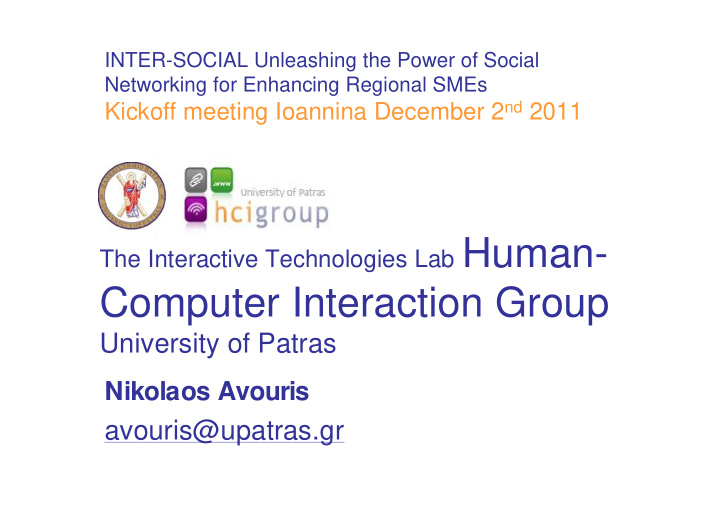



INTER-SOCIAL Unleashing the Power of Social Networking for Enhancing Regional SMEs Kickoff meeting Ioannina December 2 nd 2011 The Interactive Technologies Lab Human- Computer Interaction Group University of Patras Nikolaos Avouris avouris@upatras.gr
Where we are … Patras in Western Greece University of Patras
The University u The 3rd Greek University in terms of academic staff and number of students u 22 academic departments u Over 20,000 students currently registered of undergraduate and postgraduate level u Largest campus in Greece u Long history in competitive research and development of technology
www.upatras.gr
Rector Building
University Hospital
Largest campus in Greece over 5 km2
Interactive Technologies Lab HCI Group
n Activity: Focus on Interactive Systems Design and Evaluation n Size: 10+ researchers and support group Infrastructure: Tools for n interactive applications design, development and evaluation (Usability Laboratory )
hci.ece.upatras.gr
A historical note… 1996-2011
Actors
Usability Lab : Monitoring and logging behavioral patterns Eyetracker
- Collaborative Technologies Unit Study of phenomena of collaboration support Usability of e-learning systems The Synergo environment
Synergo : a tool for group activities Synchronous collaboration-support environment n Suitable for problem solving activities involving n diagrammatic representations
Analysis and evaluation of collaborative problem solving activities Object-orientednessof collaborative action n Dialogue events can also be related to objects manually n Objects have owners and history
Dialogue annotation Annotation of dialogue message
- Web Usability Unit website usability evaluation based on information foraging model The InfoScent Evaluator (Katsanos et al. 2007)
InfoScent : Hyperlinks Evaluator For a given user goal and user profile the semantic appropriateness of hyperlinks is evaluated and the most probable user trail predicted in order to identify navigability/findability flaws Based on Information Foraging Theory (Pirolli & Card, 1997) Latent Semantic Analysis (Landauer & Dumais, 1997) 20
InfoScent Evaluator – Parsing a page n Using “ Grab Links” button the ISEtool parses the defined “entry point page” of the site under evaluation and collects the following information for all available links: n Link Type: Is it a text link or a graphic link? n Proximal Cue: Textual description, if it is a text hyperlink or the alternative text (e.g. ALT tag), if it is a graphical hyperlink. n Link URL: The URL of the grabbed link n Target Type: The type of the pointed file (e.g. html, pdf, ppt? etc) n External?: Is the link internal or external to the defined site?
InfoScent Evaluator – Computing Scent Using “ Compute Scent” button the ISEtool computes and n returns the semantic similarity (LSA index) of the user goal against all the proximal cues of the links. Calculation of “Information Scent” for all links is achieved by n running the LSA algorithm The result is a normalized LSA index ranging from -100 n (semantically opposite) to 100 semantically identical). This index is also presented also in the internal browser of the n tool
AutoCardSorter Information Architecture Support Given a description of the pages of a web site The AutoCardSorter runs an automated analysis: LSA is used to calculate the semantic similarity among all the pages, Clustering algorithms applied to group together semantically similar pages
Web Accessibility Web site evaluation against WCAG v1.0 guidelines using IBM Rational Policy Tester
-Mobile Devices Unit User studies of activities involving mobile devices through a micro- ethnographic approach The ActivityLens (Fiotakis et al. 2007)
SolomosMuseum Mobile Application: Guide and Games
ActivityLens
ActivityLens • Synchronous presentation of multiple multimedia sources structured/unstructured media • Definition of appropriate annotation schemes • Filtering of activities focusing in different levels of abstraction • Navigation from the log file or from the video file (synchronized) • Definition of multilayer tagging • Aggregation of observation per task for all subjects
City games City games
Multi-touch surfaces
tablets
Related / activity Projects Coordinator of a Human Network on Software Usability, n funding GSRT Coordinator of a University Network on Web Science n (currently active) ModellingSpace (IST) and e-COMODE (e-ten) web based n collaborative learning environment, main development site Web usability, Greece-Italy collaboration program, (GSRT, n Italian Minstero degli Esteri) Main developer and evaluator of web sites: n www.ece.upatras.gr, www.ee.upatras.gr, www.ecedu.upatras.gr, hci.ece.upatras.gr, www.demetra- tox.net, www.synergo.gr, myece.upatras.gr, www.qualibra.eu Series/ ace/ orchestra
Services Unit User Research Services n Interaction Design & Development Services n • Interviews n • Research Review • User Needs Assessment • Field Research • Task Analysis • Focus Groups • Online Surveys • Prototyping • Usage Scenario Definition • User Model Research • Design Walkthrough • User Interface Design • Object Oriented Design and Development Usability Testing Services n • Usability Testing n • Remote Usability • Expert Evaluation • Design Walkthrough • Eye Tracking Studies
CMTool: Task Analysis
Examples of Systems developed/evaluated
SERIES Seismic Engineering Research Infrastructure Distributed Database Data Access Portal
www.orchestra-qsar.eu ORCHESTRA is an EU project, funded to disseminate recent research on computer-based in silico methods for evaluating the toxicity of chemicals.
QALIBRA
comode.com
ModellingSpace.net
Demetra-tox.net
SolomosMuseum.gr
myece.ece.upatras.gr
Recent related activity Homophily-based recommendations in social networks E. Christakopoulou, S. Daskalaki, N. Avouris. 2012 (under preparation) Data mining social network data Data from tweeter and facebook Tweet folowers Facebook similarity network
possible actors in InterSocial HCI GROUP ( http://hci.ece.upatras.gr ) n Prof. NikolaosAvouris Coordination n Dr. Christos Fidas Technical Coordination n IoannisIoannidis , Computer Engineer, Software Design and n Development IliasKotinas , Electrical & Comput. Engineer, Web Applications n Design Christos Katsanos – user studies – support on information n modeling LefterisPapachristos – user studies – visual design and credibility n Irene Hounta – collaborative systems usability n Filio Vogiantzi data entry, secretarial support n
thanks hci.ece.upatras.gr
Recommend
More recommend